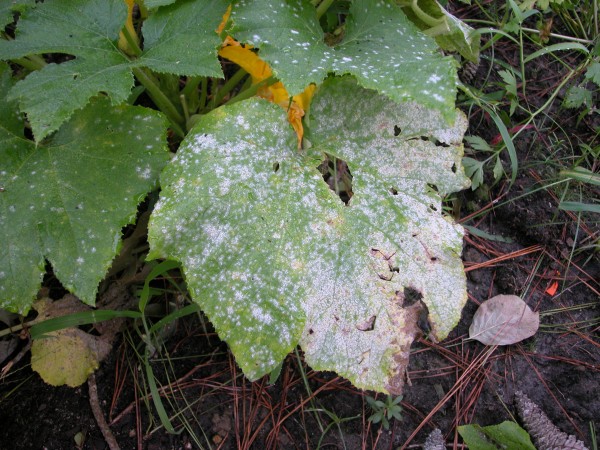-

Erin Donahue -

Christina Barkanic -

Brittany Trott -

Emily Wiley -

Jessica Reilley -

Chris Raines -

Will Nichols -

Emily Reddy -

Michele Marchetti -

Michele Frank -

James Gherardi -

Kit Henshaw -

Christina and Erin -

Kim Tait -

Erin McKinney -

Steve Spanelli -

Sam Komlenic -

Katherine Taylor Grofic -

James Eisenstein -

Jamie Oberdick -

Anna Lombardo -

LacCreta Holland -

Tony Ricci -

Local Food Journey -

Laura Young -

Kristin Camplese -

Harrison's Fresh + Local -

Danielle Matalonis -

Kristine A. -

Linda Weaver -

Naomi Elle Schwartz -

Dana Stuchul -

Cara McShane -

Brittany Smith -

Jessica Illuzzi - Frosty
-

Jessica Paholsky -

James Sechrengost -

Brad Yeckley -

Maya Althouse -

Jordan Reabold -

Kim Chase -

Maria Bryant - Alexandrea Scott
Fighting the good fight against garden diseases
Posted by Jamie Oberdick on 07/22, 2013 at 08:02 AM

Powdery mildew, a fungal disease, on a pumpkin leave
This summer has definitely been a wet one so far, and gardeners and farmers alike across Central PA know that wet weather also means plant diseases. Cloudy, humid, and downright wet conditions provide ideal conditions for these diseases to strike. However, if your plants are under the disease gun, there are ways to save your plants and ensure a good harvest, even in a less-than-ideal year like the one we are currently having. Here are some tips:
- Persistence is key: Diseases won’t take a break, and neither should you when fighting them. Be persistent; this includes a daily check for signs of disease, especially after a heavy rain. If you see anything like leaves getting spots on them, yellowing, wilting, etc., then do a quick Internet search to figure out what you are dealing with.
- Remove as much of the affected plant as you can: Carefully cut away any affected foliage, if possible. If your tomato plants are affected by the dreaded tomato killer, late blight, then you have to remove the plant entirely and either burn or throw it away. In fact, do NOT mulch any dead garden leaves, etc.
- Mulch: A layer of a few inches of mulch helps fight plant diseases. The spores that may be down in the soil sometimes gets splashed onto leaves during a heavy rain, so covering the soil with a mulch is a good idea. Since I don’t mess with any weird chemicals in my lawn, I use grass clippings. Straw is another good option.
- Give ‘em some space: While it is of course tempting to pack as many plants as possible into your garden, pay attention to recommended spacing. For example, you should have about three feet between tomato plants. Why is this important for disease prevention? It promotes good air circulation and slows down the spread of diseases. If you have disease issues, selective removal of plants may help. And plan on having more space between plants next year.
- Chemical warfare: If you do not care about keeping organic, you can find antifungal solutions at just about any greenhouse or big box store. However, I recommend doing research into what you put into your garden to learn about what effects it may have on your soil, the overall environment, and whether it is okay to use on food crops. There are organic solutions, such as copper or sulphur sprays that you can use but there are risks with these as well. Believe it or not, a very effective spray for garden plants is diluted milk (1/2 cup to 2 cups water). Milk briefly turns into a disinfectant when exposed to sunlight, killing fungal spores.
- Rotate your crops: For some plant diseases, it’s a good idea to rotate affected crops away from those areas. For example, if you get mosaic virus on your beans, it’s a good idea to plant them in another spot in the garden next year.
![]() Author: Jamie Oberdick
Author: Jamie Oberdick
Bio: Editor, Local Food Journey | Passionate about supporting local food in Central PA
- Our Local Food Journey comes to an end
- Winter isn’t a quiet time at the farm
- Get the taste of garden season right now by growing herbs indoors
- All you need to know about PASA’s Farming for the Future conference









NO COMMENTS